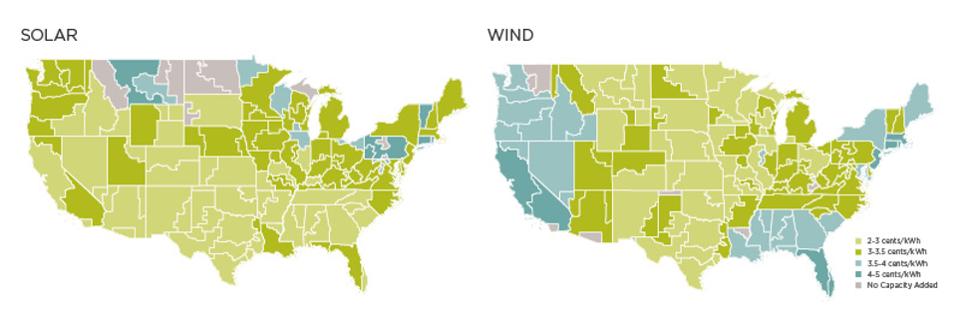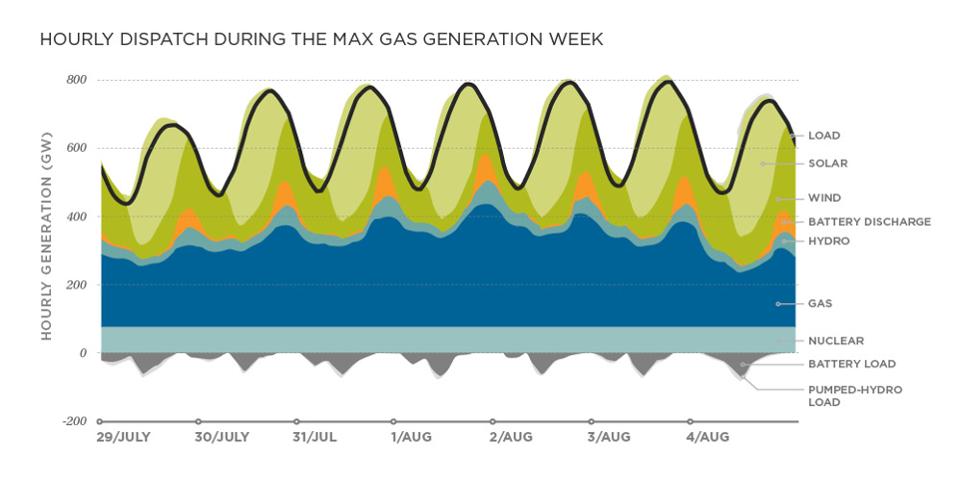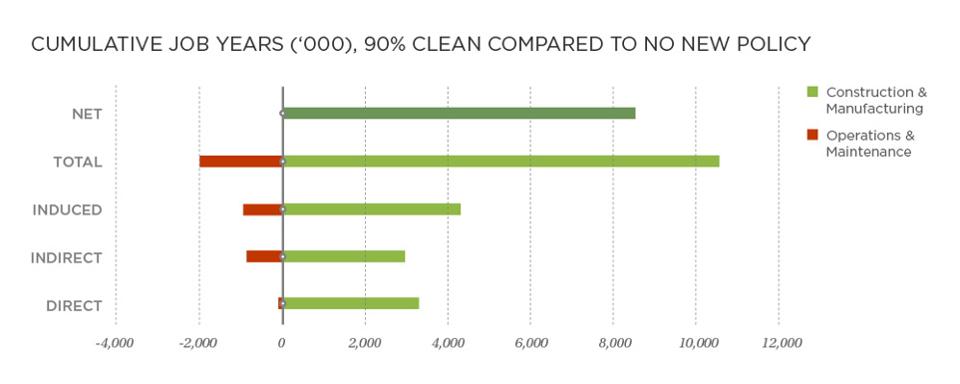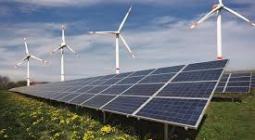Plunging renewable energy prices mean U.S. can hit 90% clean electricity by 2035 without extra cost.

Renewable energy has historically been considered too expensive and too unreliable to power our grid, but new research has overturned that trope for good. Plummeting wind, solar, and storage prices have fallen so fast that the United States can reach 90% clean electricity by 2035 – without raising customer costs at all from today’s levels, and actually decreasing wholesale power costs 10%.
Building a 90% clean electricity system by 2035 would catalyze massive economic growth that helps pull the U.S. out of the COVID-19 recession by supporting more than a half million new net jobs per year, injecting $1.7 trillion into the economy, and recharging domestic manufacturing. Technology-neutral policies can reach a 90% clean power system, help energy developers and investors prosper, and pave the way for technologies of the future.
90% clean electricity requires no new fossil fuel power plants, with all existing coal plants retiring in an orderly fashion and natural gas consumption falling 70% over time, so utilities can recover outstanding fixed costs and avoid stranded assets. These closures would reduce economy-wide emissions 27% by 2035, and avoid $1.2 trillion in environmental health costs from fossil fuel emissions by 2050.
Add it all up, and a 90% clean electricity system is a no-regrets blueprint for investing in America’s future, stimulating a healthier innovation economy, and creating new jobs – all without raising electricity bills.
90% clean electricity would actually decrease U.S. power costs
The new research, issued by the Goldman School of Public Policy at the University of California, Berkeley, is the first study to definitively show wind, solar, and storage can deliver massive emission reductions and economic growth without increasing consumer costs. The exhaustive modeling simulates hourly U.S. power system operation over 60,000 hours across 134 regional zones, 310 transmission lines, and more than 15,000 individual generators.
Previous research proved power sector decarbonization was possible by 2050, but with substantially higher customer prices – for instance, the National Renewable Energy Laboratory’s 2014 Renewable Energy Future report found 90% clean energy by 2050 would significantly increase electricity prices relative to 2010.
Fast-falling renewable and energy storage costs have changed this outlook – clean energy is now cheaper than fossil fuels, and actual costs in 2018-2019 were lower than previously projected costs for 2030-2035. Research has shown that by 2025 86% of the U.S. coal fleet will cost more to run than replacing it with local wind and solar generation, and clean energy portfolios of renewables and storage are cheaper than new natural gas generation.
Because prices have fallen so fast, a 90% clean electricity system would actually decrease wholesale power costs 10% by 2035 compared to current levels. It’s important to note this research defines “clean” as any generation that does not produce direct carbon dioxide (CO2) emissions, so technologies like nuclear power and carbon capture and storage (CCS) can contribute to a clean energy future.
While policy should remain technology neutral, today’s levelized cost of energy of roughly 2-4 cents per kilowatt-hour (kWh), even in regions of the country with low-quality renewable energy resources, mean a least-cost analysis does not build any nuclear or CCS.

UNIVERSITY OF CALIFORNIA-BERKELEY
Most existing research targeted 2050 as when a net zero power sector was possible, but targeting 90% clean electricity by 2035 leverages existing low-cost options to achieve the emissions reduction pace required for a safe climate future. Rapidly adding clean energy also paves the way for electrification to cut transportation and building emissions, and accelerates deployment of the clean energy technologies needed to displace the final 10% of power sector emissions.
“We’re talking about the ability to achieve near-100% clean electricity by 2035, in half the time most people are talking about,” said David Wooley, UC-Berkeley professor and a lead author on the report.
90% clean electricity requires a massive wind, solar, and storage buildout
Building a reliable 90% clean electricity system by 2035 requires a massive buildout of wind, solar, and energy storage – but no new fossil fuel generation. 1,100 gigawatts (GW) of new wind and solar generation must be built, roughly doubling U.S. generation capacity. The report also estimates about 150 GW of new four-hour energy storage would cost-effectively balance any intermittency.

UNIVERSITY OF CALIFORNIA-BERKELEY
While adding about 70 GW per year is more than twice the current national installation rate, the U.S. Energy Information Administration forecasts more than 37 GW of wind and solar will be built in 2020. And more than 500 GW of wind, solar, and battery storage are currently proposed and waiting in interconnection queues across the U.S.
In addition, the U.S. added roughly 65 GW of natural gas capacity in 2002, but wind and solar have shorter construction times than natural gas and don’t require a pipeline connection, indicating the 90% clean buildout is challenging but possible.
Adding all this clean energy would support approximately 9 million new net job-years in the energy sector through 2035, totaling 530,000 more jobs per year compared to business-as-usual, in every corner of the country. Clean energy jobs offer higher wages than the average economy, can’t be outsourced, and are widely available to workers without college degrees, opening up economic opportunity for all Americans.

UNIVERSITY OF CALIFORNIA-BERKELEY
Because renewable energy prices have fallen so fast, they are now cost-competitive in all regions of the U.S., and only require modest upgrades to long-distance transmission lines, with significant “spur line” investments that avoid crossing multiple communities and states, only adding 0.2 cents/kWh to total system costs.
The report authors note their modeling represents a conservative strategy for power sector decarbonization, as it retains all existing hydropower and nuclear generation capacity under the 90% clean electricity total (after accounting for planned retirements). Natural gas generation declines by 70%, but a substantial share of existing capacity would be retained to help balance the grid’s last 10% of generation needs, while allowing enough time for existing uneconomic but undepreciated fossil fuel generation to recover fixed costs.
Massive public health benefits from 90% clean electricity
90% clean electricity would create massive public health benefits alongside this sustained economic growth and prevent 85,000 premature deaths from power plant emissions by 2050. Emissions would be virtually eliminated from the U.S. power sector: CO2 emissions would be reduced 1,300 million metric tons (88%) by 2035, while nitrogen oxide emissions would fall 96% and sulfur dioxide emissions would be cut 99%
Smart policy action unlocks 90% clean electricity
But plummeting prices for wind, solar, and energy storage aren’t sufficient to clean up the grid on their own – without policy intervention, clean energy would only comprise 53% of total U.S. electricity by 2035. Utilities need assistance retiring uneconomic existing fossil fuel power plants, wholesale electricity market design can be inherently biased toward fossil fuel generation even if they cost more to run than clean energy, and air pollution’s economically damaging impacts aren’t addressed by current policies.
The 2035 report was accompanied by technology-neutral policy recommendations for Congress, federal department and national labs, governors and state legislatures, and electricity market regulators to help reach a 90% clean electricity future:
- Congress should adopt a federal clean electricity standard reaching 55% by 2025, 75% by 2030, 90% by 2035, and 100% by 2045; states should adopt clean energy standards of 90% by 2035 or earlier and 100% by 2045 (or earlier).
- Congress should extend existing federal clean energy investment and production tax credits, making energy storage eligible, and convert credits to more liquid incentives.
- Federal and state policymakers should help refinance bad coal debt to reduce the costs of a coal-to-clean transition, and support coal-dependent communities by shoring up pension and healthcare services while funding worker retraining for the clean energy economy.
- Congress and federal officials should streamline renewable energy and transmission siting and regional planning, while reducing interconnection costs.
- Federal and state policymakers should invest in R&D policies to develop the future technologies needed to reach 100% clean electricity.
- Federal and state policymakers should reform wholesale markets and utility business models to fairly value clean energy and support investment in a least-cost, technology-neutral portfolio of energy resources.
Massive economic growth and a safe climate future
Decarbonizing our electricity system has never been more important – climate change caused by greenhouse gas emissions is already hammering our communities through extreme weather and excessive heat. The COVID-19 recession has compounded that challenge with the need to rebuild our economy and put Americans back to work.
Thankfully, the plummeting price of renewables and energy storage have made both goals possible, at no extra cost to consumers. By taking smart policy action, our federal and state leaders can create massive economic growth that also secures a safe climate future.
9 June 2020

UNIVERSITY OF CALIFORNIA, BERKELEY




